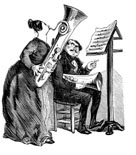
A Real Folk Mass
GUEST COLUMN
My decision to enter the Catholic Church in an Eastern Rite rather than in the Roman Rite was a complicated one. But one clear and powerful motivation was the difference in congregational singing. For many years I had been a member of the Mennonite denomination, which is renowned for its unaccompanied and full-throated congregational singing. In the Mennonite church everybody sings, with gusto, and usually in crisp four-part harmony. When I began to attend Masses in Roman Rite churches, the various parishes I visited shared a single dispiriting pattern of liturgical music: A few hymns would be sung anemically, with no attempt at harmony, by a handful of parishioners, while most of the congregation mutely examined the backs of the pews in front of them. To a lover of church music, it was heartbreaking.
But in the little parish of St. Mary’s Byzantine Catholic Church, I found that the entire liturgy was sung, and that the entire congregation joined in it, faltering only at some of those troparia and kontakia and other exotically named responses that not everyone knows by heart. I even heard a little harmony tentatively entering the responsorial singing. This wholehearted participation in the sacred music was one of the things that won me to the Eastern Rite, and at St. Mary’s I am not only an enthusiastic member of the singing congregation but also one of the cantors. Our communal singing may not be quite up to the Mennonite standard, but at least it is singing.
Therefore, when it was announced that the Byzantine Seminary in Pittsburgh would be hosting a four-day “School for Cantors,” I signed up at once. Here, I imagined, would be an opportunity to hear the Byzantine liturgy sung in all its glory, as experienced cantors got together with novices who had mostly, unlike me, been raised in the Byzantine tradition and had the music in their bones.
My anticipation was great, then, when we assembled for the morning liturgy that was to inaugurate the sessions. Into the seminary’s little jewel of a chapel filed scores of people — men and women, old and young — who solemnly blessed themselves in the “backward” Eastern fashion, and knelt to pray. As the air filled with incense, my heart soared to the heavens.
You May Also Enjoy
The Schola Cantorum of the Pacific is a living celebration of liturgy as community and music as its exalted language.
Kneeling had always meant self-abnegation. To kneel in church was to blend in utterly, to be one more duck in a pond of ducks. Now I felt as if I were showing off.
Regarding religious observance, obligation is a large part of the act itself, and the benefit. Both having the obligation and meeting it form us.

